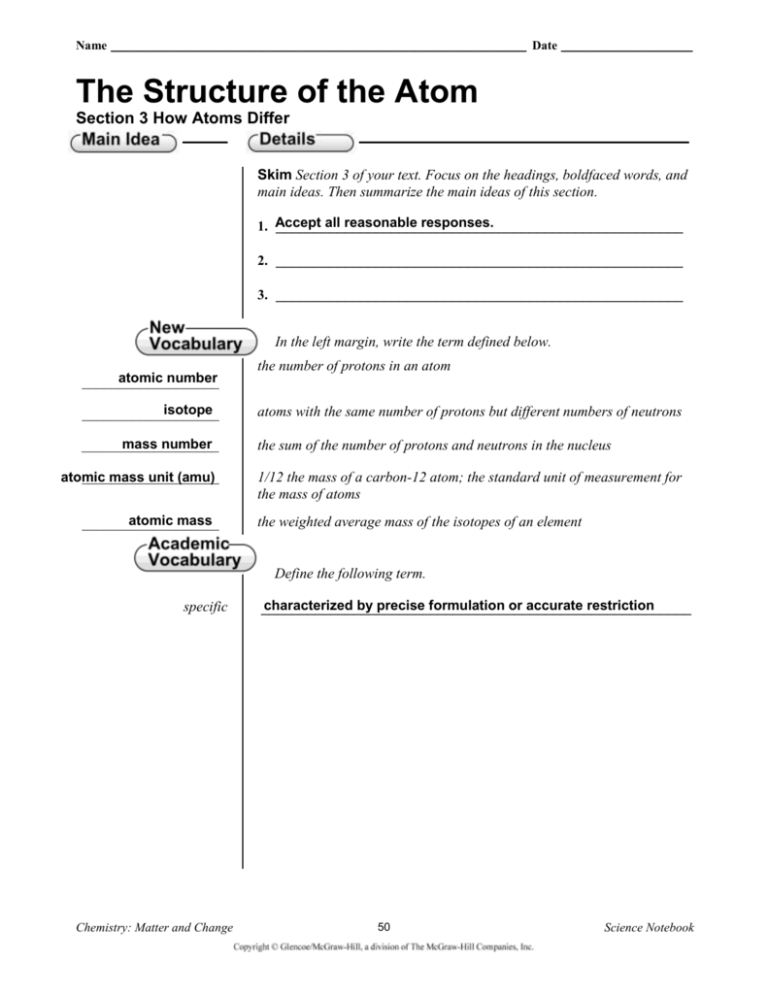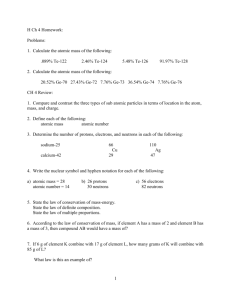RG 4.3 Solutions
advertisement

Name ____________________________________________________________ Date ___________________ The Structure of the Atom Section 3 How Atoms Differ Skim Section 3 of your text. Focus on the headings, boldfaced words, and main ideas. Then summarize the main ideas of this section. all reasonable responses. 1. Accept _____________________________________________________ 2. _____________________________________________________ 3. _____________________________________________________ In the left margin, write the term defined below. atomic number ___________________ the number of protons in an atom isotope ___________________ atoms with the same number of protons but different numbers of neutrons mass number ___________________ the sum of the number of protons and neutrons in the nucleus ___________________ atomic mass unit (amu) atomic mass ___________________ were actually a stream of charged particles. specific Chemistry: Matter and Change 1/12 the mass of a carbon-12 atom; the standard unit of measurement for the mass of atoms the weighted average mass of the isotopes of an element Define the following term. characterized by precise formulation or accurate restriction ________________________________________________________ 50 Science Notebook Name ____________________________________________________________ Date ___________________ Section 3 How Atoms Differ (continued) Atomic Number Use with page 115. Explain how to use an atomic number to identify an element by completing the paragraph below. protons Since atom Each _________ of an element has a unique number of __________. neutral the number of _________ protons equals the overall charge of an atom is _________ protons number electrons Atomic number number of ________ the number of _________. electrons If you know how many one of the three an atom contains, of ___________. atomic number two you also know the other _________. Once you know the _______________, element periodic table can be used to find the name of the _____________. the ________________ Atomic Number Solve Read Example Problem 1 in your text. Use with Example Problem 1, page 116. You Try It Problem Given the following information about atoms, determine the name of each atom’s element and its atomic number. a. Atom 1 has 11 protons b. Atom 2 has 20 electrons 1. Analyze the Problem Apply the relationship among atomic number, number of protons, and number of electrons to determine the name and atomic number of each element. 2. Solve for the Unknown a. Atom 1 Atomic number number of protons number of electrons 11 Atomic number ________ number of electrons sodium (Na) The element with an atomic number of 11 is _______________ b. Atom 2 Atomic number number of protons number of electrons 20 Atomic number number of protons ______ calcium (Ca) 20 The element with an atomic number of __________ is _____________. 3. Evaluate the Answer atomic numbers and element The answers agree with ____________________ symbols ___________________________ given in the periodic table. Chemistry: Matter and Change 51 Science Notebook Name ____________________________________________________________ Date ___________________ Section 3 How Atoms Differ (continued) Isotopes and Mass Number Use with page 117. Review your understanding of isotopes and mass number by completing the following paragraph. the same number of protons but with Isotopes are elements with ______________________________ differing numbers of neutrons The number of neutrons can be _______________________________. subtracting determined by _________________ the atomic number from the mass number ____________________ . The mass number is the number of protons plus neutrons in an atom _________________________________________________________ . Use Atomic Number and Mass Number Use with Example Problem 2, page 118. Solve Read Example Problem 2 in your text. You Try It Problem You are given two samples of carbon. The first sample, carbon-12, has a mass number of 12, the second sample, carbon-13, has a mass number of 13. Both samples have an atomic number of 6. Determine the number of protons, electrons, and neutrons in each sample. 1. Analyze the Problem Known: Carbon-12 Carbon-13 12 Mass number is _______ 13 Mass number is _______ 6 Atomic number is ______ 6 Atomic number is ______ Unknown: The number of protons, electrons, and neutrons in each sample. 2. Solve for the Unknown 6 Number of protons = number of electrons = atomic number = _____ Number of neutrons = mass number atomic number 6 The number of neutrons for carbon-12 = 12 6 = _______ 7 The number of neutrons for carbon-13 = 13 6 = _______ 3. Evaluate the Answer mass number minus The number of neutrons does equal the __________________ atomic number or the number of protons. the _________________, Chemistry: Matter and Change 52 Science Notebook Name ____________________________________________________________ Date ___________________ Section 3 How Atoms Differ (continued) Mass of Atoms Use with pages 119–120. Explain why the mass number for chlorine is more than 35. Elements can have several isotopes. Each isotope has a different number of ________________________________________________________ neutrons. Therefore each isotope has a different mass. The atomic mass of an ________________________________________________________ element is a weighted average mass of all the isotopes of that element. ________________________________________________________ Calculate Atomic Mass Use with Example Problem 3, page 121. Summarize Fill in the blanks to help you take notes while you read Example Problem 3. Problem calculate the data Given the __________ in the table in the left margin, ____________ atomic mass of unknown element X. Then, _________ identify the unknown ______________ Isotope Abundance for Element X Isotope 6 7 Mass Percent (amu) abundance X 6.015 7.59% X 7.016 92.41% medically to treat some _________________. mental disorders element which is used __________ ________, 1. Analyze the problem Known: Unknown: atomic mass _________________ of X ? amu 6 For isotope X: name 6.015 amu mass _________________ ___________ of element X ? 7.59% 0.0759 abundance ____________________ For isotope 7X: 7.016 amu mass ________________ 92.41% 0.9241 abundance ____________________ 2. Solve for the unknown mass percent abundance Mass contribution (________) (_____________________________) 0.4565amu (6.015 amu)(0.0759) ___________ For 6X: Mass contribution ____________________ 6.483amu amu)(0.9241) __________ For 7X: Mass contribution (7.016 ____________________ Sum the mass contributions to find the atomic mass. 6.939 amu Atomic mass of X _________________________ (0.4565 amu + 6.483 amu) __________ _____________ periodic table Use the ____________________ to identify the element. lithium The element with an atomic mass of 6.939 amu is __________. 3. Evaluate the answer mass number minus the The number of neutrons does equal the ________________ protons atomic number ______________________, or number of ____________. Chemistry: Matter and Change 53 Science Notebook








